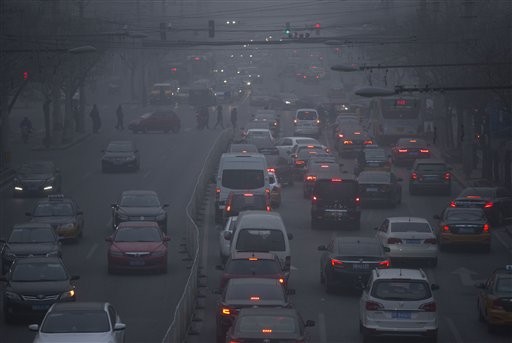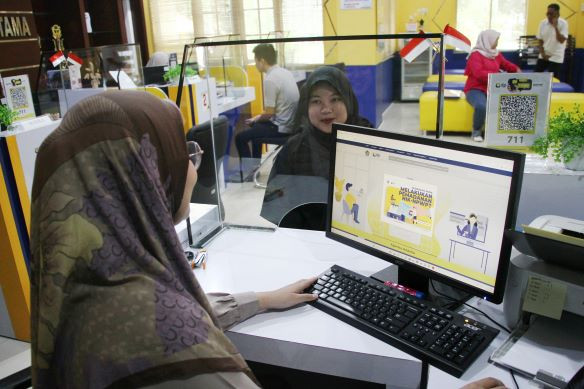'Airpocalypse' is not the future we want
We have talked to villagers and medical workers in villages close to a coal-fired plant in Java. Respiratory problems are common, with people frequently complaining of coughs and shortness of breath, all year round. Many patients are very small children.
Change Size
 Pedestrians make their way across a busy intersection on a day with severe air pollution in Beijing, Dec. 25, 2015. (AP/Mark Schiefelbein)
Pedestrians make their way across a busy intersection on a day with severe air pollution in Beijing, Dec. 25, 2015. (AP/Mark Schiefelbein)
I
span style="color: rgba(0, 0, 0, 0.8); font-family: Acta-Book; font-size: 17px; line-height: 24.2857px;">Indonesia needs more energy as millions still have no access to electricity and in growing cities, power supply is unreliable.
That’s why the government has pledged to increase energy output by 35 gigawatts ( GW ), based on an assumption that demand will grow by 8 percent a year — a prediction that many have criticized as excessive. What is more significant for Indonesia’s future, though, is that two thirds of this 35 GW is expected to come from coal.
Most of Indonesia’s electricity already comes from coal, and the price being paid for this is clear to see. Water resources have been polluted in Kalimantan, farmers deprive of their land in Java and anyone who lives near a coal-fired power plant is having their health damaged by emissions.
A study carried out by Harvard University, and commissioned by Greenpeace, looked at the health impacts of air pollution from coal-fired power plants in Indonesia. Its findings show that existing power plants cause an estimated 6,500 premature deaths every year, from diseases like stroke, heart disease, lung cancer and respiratory illness. If the government goes ahead with plans to allow more than 100 new coal-fired plants, this number could rise to 28,300 people dying before their time every year, according to the study.
An ordinary Indonesia might rightfully ask, “Where is the data on this air pollution?” Shamefully, there is almost no air-quality monitoring in the country, and controls on power plants are lax. Indonesia, like its Southeast Asian neighbors, allows new coal-fired power plants to emit 5-10 times the amount of major pollutants permissible in China, the US and the EU, and it does not generally require emission controls for SO2 or NOx to be installed.
We have talked to villagers and medical workers in villages close to a coal-fired plant in Java. Respiratory problems are common, with people frequently complaining of coughs and shortness of breath, all year round. Many patients are very small children.
It is not only families living nearby who suffer. The pollution from coal-fired power plants spreads over a large area, hundreds of kilometers from the plant. The WHO recognizes in particular the dangers of very fine particles, known as PM2.5, in these emissions. The particles are so small that they enter the lungs and the bloodstream, making them more toxic and harmful than larger particles. Most of the health impacts of coal emissions are caused by PM2.5.
You have only to look at China to see how dangerous coal pollution can be. For many years, China’s reliance on coal pushed the country’s air pollution to crisis levels. Beijing has experienced several days of what’s become known as Airpocalyse — when the city is covered in a thick, choking smog and PM2.5 levels rise to nearly 30 times the level deemed safe by WHO. Researchers estimate that air pollution in China kills an average of 4,000 people a day, with coal burning the principal cause.
It’s no wonder that popular anger has forced the Chinese government to reduce coal burning, imposing a moratorium on new coal-fired power plants until the end of 2017.
That is not the future we want for Indonesia. Yet, as China begins to turn its back on coal, Indonesia seems ready to buy their secondhand technology to build coal plants here.
India has taken over China’s unenviable reputation for pollution — the four most polluted cities in the world are in India. Its electricity generation is also built on coal, but that has failed to keep the lights on in India. The government now has plans to install 100 GW of solar power by 2022 — 20 times current solar power production. And the best news of all? The country’s energy minister, Piyush Goyal, says it’s a more cost-effective option than coal.
Good news from Indonesia in recent weeks though, with President Joko “Jokowi” Widodo announcing the moratorium on coal mining licenses. This new policy is expected to shift the direction of development toward a greener path.
Indonesia does not deserve, and cannot afford, a future built on coal. It is time to break free and take a new path, based on our abundant renewable energy resources.
***
The writer is climate and energy team leader at Greenpeace Indonesia.
---------------
We are looking for information, opinions, and in-depth analysis from experts or scholars in a variety of fields. We choose articles based on facts or opinions about general news, as well as quality analysis and commentary about Indonesia or international events. Send your piece to community@jakpost.com.









